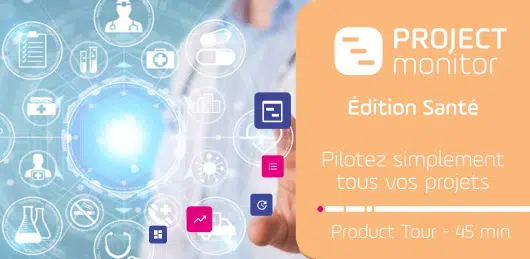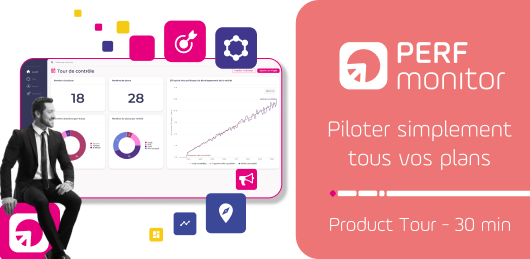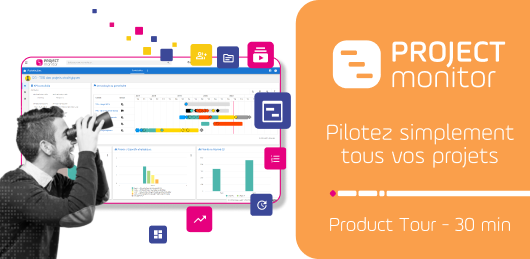How do you get your projects off the ground?
Conference recording
Answers to your questions
⟫ "A PMO role has a cost: what arguments can you use to defend an ROI, apart from the fact that you'll get a better view of project progress?"
Arguments in favor of the ROI of a PMO unit relate to both operational and strategic areas. At the operational level, the practice of project management is instilled through a common framework, translated into processes and supported by one or more tools (not just PPM, but also via templates). Project managers are supported as they grow in maturity, and thus in their ability to steer their projects and provide reliable visibility of what's happening on their project. The PMO is often the guarantor of compliance with the project management methodology, as well as a referent for any steering tools in place (at the very least, a referent for good project steering practices). At the strategic level, the PMO will enable the consolidation of data from the various projects, through project portfolios, notably to ensure proper alignment with the organization's strategic challenges . The information it provides will enable Top Management to make better-informed investment decisions. It is also there to ensure that the overall commitments made at the beginning of the year are respected, in terms of both capacity to deliver and budgetary elements. It also acts as a link between the players in these 2 areas, facilitating and streamlining exchanges, communication and the circulation of information. The subject of the ROI of a PMO unit is often raised, as some organizations are "hesitant" to take the plunge: we are considering organizing a future webinar on the subject.
⟫ "In the local civil service, if maturity is not sufficient, should a training course, particularly for executives and top managers, be offered?"
Indeed, for overall management to work, it doesn't just take place on projects and programs, through project managers and program directors. It involves the whole organization, including middle and top management. To measure your organization's level of maturity, we advise you to carry out an audit of steering practices, involving all the players concerned, from both the operational and strategic domains. In addition, a skills and interpersonal skills mapping tool can help you identify individual areas to capitalize on, and, conversely, areas that need to be improved or professionalized through tailored, non-generic training courses. These training courses also concern all those involved in the piloting process, whether actors or customers. Post-training actions such as on-the-job coaching can also be envisaged.
⟫ "Is the paradigm shift towards agility at scale compatible with roadmap steering?"
Agility at scale is increasingly present in organizations to respond more precisely, and with greater responsiveness, to the needs of Business Units, Customers... In this context, projects have already turned to practices based on Agile principles to optimize their "time-to-market". However, this must also be reflected in the strategic domain, at the level of more global management, notably through roadmap management. An increasing number of organizations have set up iterative roadmap reviews at regular times of the year, which means that the various parties involved in this overall management process must themselves be trained and made aware of the principles of Agility. In practice, this large-scale agility dynamic must involve the whole organization (and not just CIO), in order to spread this common culture, favoring collaboration, interaction and a fluid flow of information. The role of the PMO unit is also impacted, with changes in its day-to-day activities.
⟫ "I understand that a webinar organized by Virage advocates the implementation of tooling but I don't quite see the link between the tool and the process, an advanced level of maturity can certainly be achieved with xls, ppt, teams tooling ..."
If the management processes within an organization are not defined, i.e. the management and operating rules in terms of management (demand, project, portfolio, budget, resources), then a PPM tool such as Project Monitor or others will not be sufficient to deliver value. Even if a PPM tool can provide a certain steering framework (standardized processes contained in the tool), it will not reflect the target operating mode that steering should be. This is why, before choosing any kind of management tool, we strongly recommend that you think about and define your own management operating rules: the tool will only be a carrier of these processes. In the field, it will save you time in consolidating and analyzing management data, but only if these rules are first defined and supported by the tool through processes. In our 20 years' experience of supporting organizations in their management, we have found that the most mature companies were those which had defined these famous management operating rules (processes), supported by a PPM-type tool, which saved them time in consolidating and analyzing data; compared with companies which had also defined their processes, but supported by less professional tools. Data compilation, completeness and analysis were more tedious and time-consuming.
⟫ "When you have to deploy PMO in several departments of a departmental council, and some projects are cross-functional and/or co-piloted, would you suggest one base or several bases?
In an ideal organization, the PMO would be deployed by directorate / service / department (decentralized steering unit) but with a central body (central steering unit). The decentralized PMOs are the relays of the central PMO in the directorates / services / departments. At portfolio level (what you call "base"), you can have one portfolio per management / service / department, piloted by each decentralized PMO. The grouping of these n portfolios constitutes the corporate/organizational portfolio, which is managed by the Central PMO, who also consolidates budgetary and capacity elements, but who also manages the eligibility of future projects with regard to what is being done in the field through each project portfolio.
⟫ "As a beginner in our project planning and monitoring department, I would like to know what tools/works/techniques I need to know in order to master the project management process from start to finish?"
There are a number of methodological repositories on which you can draw, such as the Prince II repository, PMI's PMP or the repositories linked to Agile principles (Agile Manifesto, SAFe Agilist...). In addition, depending on your level, training in the fundamentals of project management can be a very good starting point.
⟫ "And if we have to explain what the project method is to executives and top managers, raising awareness can't be enough, so what do we do?"
It is necessary to give meaning to the practice of steering, whatever the actors and their position in the organization. Evangelizing, training, coaching and supporting don't just concern project managers and contributors: all those involved in steering practices, whether in the strategic or operational domain, need to understand the value of steering and the value it brings (both on an individual and a more global level). At the same time, Top Management must be able to express what it needs, in terms of information and visibility, to be able to decide, arbitrate and be accountable. Hence the importance of highlighting the benefits, added value and meaning of steering practices within an organization.
⟫ "Can we have some practical tools for project portfolio management?"
When we talk about project portfolio management, this can only be done by relying on tangible elements: the management and monitoring of a project's progress, the control of its risks, but also the management of its resources and budget. On a consolidated basis, the practice of portfolio management involves consolidating all these elements - or even indicators - relating to the projects that make up the portfolio. This is why, in addition to the portfolio, we use a resource capacity plan and a monitoring of budgetary elements in relation to the envelope initially validated at the beginning of the year. In addition, in order to assess the performance of a project portfolio, it is important to identify performance indicators other than the compilation of project indicators (cost / quality / lead time / risks...). For example, indicators will be identified and measured that reflect the portfolio's alignment with the challenges strategic objectives set out in the roadmap.
Upcoming events

Jeudi 11 septembre 2025
Vous travaillez au sein d'un établissement de santé ? Découvrez en 45 minutes pourquoi passer à un outil PPM pour le succès de vos projets ! Découvrez les fonctionnalités clés qu’affectionnent nos clients de CHU, CHRU et GHT, pour la gestion de leur portefeuille de projets.

Mercredi 15 octobre 2025
Découvrez comment obtenir une vision centralisée de tous vos plans, vos axes et vos actions ! Explorez les fonctions clés de Perf Monitor et posez vos questions.

Jeudi 16 octobre 2025
Explorez le logiciel Project Monitor : centralisation de tous les projets, assurance de l’alignement stratégique et diffusion des bonnes pratiques projet. Ne manquez pas ce Product Tour en direct.